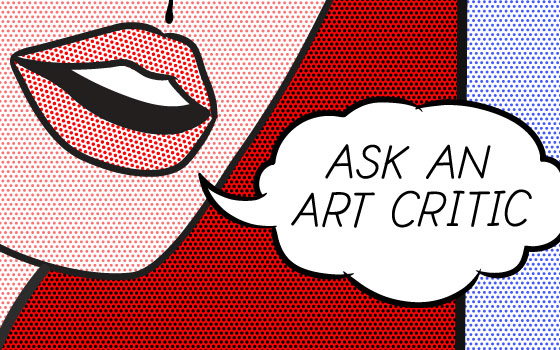
In his weekly column, Jerry Saltz dispenses art advice to all comers. Got a question for Jerry? Send it to [email protected].
Dear Jerry,
Last week you wrote about how you love getting to the MetÔÇÖs permanent collection right after you walk in the front door. (So do I.) You alluded to other New York museums that donÔÇÖt work so well. What about them?
ÔÇöKent Conaway
Dear Kent,
New York being what it is, our museums are vertical, not horizontal. That means the stumbling blocks to architectural clarity are unavoidable ÔÇö but certainly surmountable. I have to admit that I was being circumspect about other New York museums because one of them is just so bad.
LetÔÇÖs take the big institutions one at a time, from north to south. Even if you donÔÇÖt like seeing art at the Guggenheim, you have to admit that itÔÇÖs breathtaking to walk into Frank Lloyd WrightÔÇÖs radical interior tornado. The instant you enter, the space corkscrews, contorts, zooms away, gets bigger than it looked from the outside, evokes nostalgia and failed utopias. Strictly speaking, however, the Guggenheim isnÔÇÖt primarily a museum with a permanent collection. ItÔÇÖs more of a Kunsthalle for rotating exhibitions. The former director, Thomas Krens, spent much of the past two decades developing branches rather than creating a guiding vision, and it hurt the institution. However, he had one strong suit: If Genghis Krens said something should be done, it got done, no matter how craven and confused. The new director, Richard Armstrong, might want to take this one page from KrensÔÇÖs evil playbook and make more bold decisions. (At the moment, the Guggenheim is in the same position as the Mets: once great. Will the board do what the Mets did, and give their new general manager total dictatorial powers?)
WeÔÇÖll skip the Whitney for now, because itÔÇÖs in flux. The new downtown building is still somewhat mysterious, and if itÔÇÖs designed even half-right, the Whitney could easily up being the art worldÔÇÖs favorite museum. Fingers crossed.
IÔÇÖm an art dealer. Last week you freaked out about a hundred of us when you wrote about not wanting us to talk to you about the art in our galleries. Should we keep our distance? Not talk to you at all? You seem pretty talkative to us.
From here you go back and forth up the escalators until reaching the fifth floor. You get off, turn a corner, go through a narrow hall, over a narrower walkway that looks down at the boxy atrium below, then pass a restaurant where theres usually a line snaking around another corner. Welcome to the entrance! Once youre inside, the conditions are so crowded and cramped that  well, good luck.
Dear Jerry,
IÔÇÖm an art dealer. Last week you freaked out about a hundred of us when you wrote about not wanting us to talk to you about the art in our galleries. Should we keep our distance? Not talk to you at all? You seem pretty talkative to us.
ÔÇöOneOf100s
Dear OneOf100s,
I got a lot of e-mails from irked art dealers on this one, so let me explain. I never said dealers shouldnÔÇÖt talk to me. IÔÇÖd be crushed if they didnÔÇÖt. I wrote ÔÇ£I love dealers. Art dealers are my favorite people in the art world,ÔÇØ and added that the one thing I donÔÇÖt want dealers to do is guide me through their shows, pitching me. When they do this, it destroys the experience. After I finish looking at a gallery show, I love chatting about exhibitions weÔÇÖve seen, news, gossip, Larry Gagosian, Jeffrey DeitchÔÇÖs latest zany idea, and how annoying curators can be. Yes, the dealer-critic relationship is tricky, and I know that many critics want to be told by dealers and artists what the work is about. IÔÇÖm not one of them. I like to look on my own.
Dealers, please donÔÇÖt stop talking! Your galleries are special to me: They are wormholes, time machines, matter transporters, gardens of delight, shtetls, hellholes, mediocrities, meritocracies, Dixieland tunes, places to get to the bottom of things, voting booths, fun fairs, tranquilizer bullets, big trees, missing links, states of grace, secular temples, travel bureaus, shallow ends of the pool, deep ends of the ocean, shelters from the storm, nails in your back, stones in your shoe, vicious circles, and burning rings of fire.
Dear Jerry,
You said that dealers should save their sales pitch for the clients. IÔÇÖm an artist. CouldnÔÇÖt a tactful artist pitch a critic without being obvious?
ÔÇöBrian Sherwin
Dear Brian,
Nope. And donÔÇÖt try, because we can see right through you. As it is, about 75 percent of everything an artist does or says in connection with his or her work is a ÔÇ£sales pitch.ÔÇØ ThatÔÇÖs precisely why you shouldnÔÇÖt give it to a critic. YouÔÇÖre already thisclose to being craven all the time. You may think youÔÇÖre being subtle, but youÔÇÖre not. ItÔÇÖs like when youÔÇÖre stoned and you try to act straight: You just come off like some nut with crumbs on your shirt.
If youÔÇÖre obnoxious and clueless enough to come out and say, ÔÇ£Write about my showÔÇØ:
1. You sound like an annoying nag.
2. YouÔÇÖre telling someone else what he or she should do at work.
3. YouÔÇÖre saying something that goes without saying.
Artists: You can and should let critics know your show is up, and express a desire that weÔÇÖll see it. Remember that weekly critics at magazines like New York write only about shows that are currently on view, only about shows that will be up for a while after the review is published, and only about shows that are in public locations with regular hours (not your studio!). IÔÇÖll save for another column my follow-up advice: things artists and dealers can, should, and shouldnÔÇÖt do after receiving a good or bad review.

